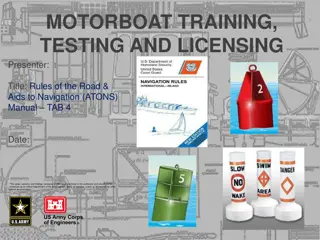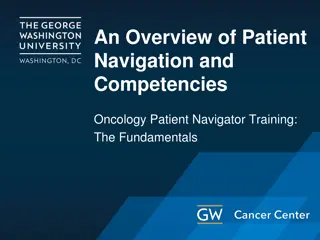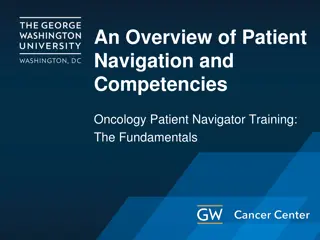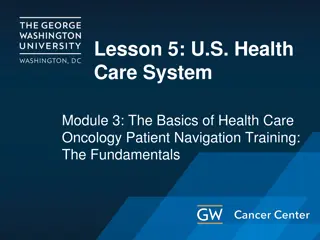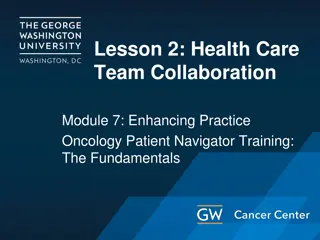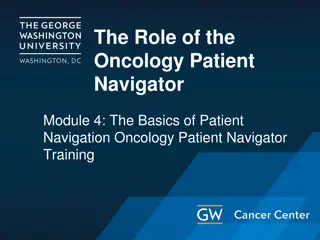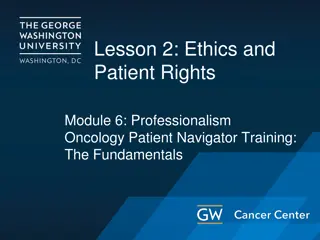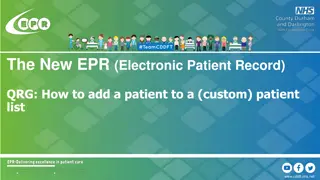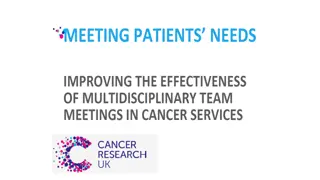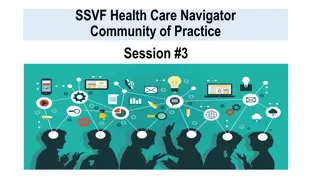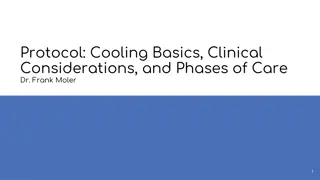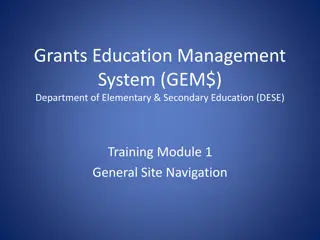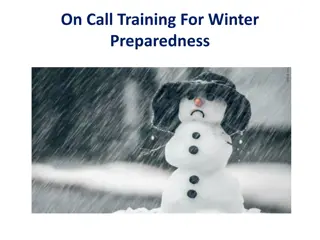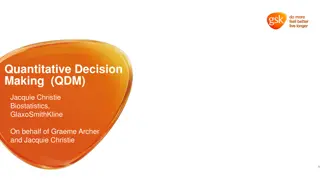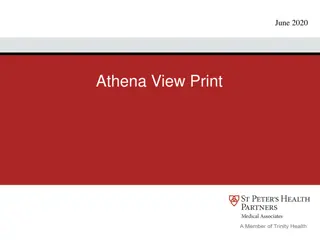Basics of Shared Decision-Making in Patient Navigation Training
Shared decision-making is a collaborative process between patients and clinicians in treatment planning. This lesson covers empowering patients to communicate preferences, determining treatment priorities, and supporting patients in decision-making. It also includes assessing barriers to adherence and developing plans for addressing challenges. Key competencies for patient navigators and learning objectives are highlighted.
Download Presentation

Please find below an Image/Link to download the presentation.
The content on the website is provided AS IS for your information and personal use only. It may not be sold, licensed, or shared on other websites without obtaining consent from the author. Download presentation by click this link. If you encounter any issues during the download, it is possible that the publisher has removed the file from their server.
E N D
Presentation Transcript
Lesson 3: Shared Decision- Making Module 4: The Basics of Patient Navigation Oncology Patient Navigator Training: The Fundamentals
Acknowledgments This work was supported by Cooperative Agreement #1U38DP004972-02 from the Centers for Disease Control and Prevention. Its contents are solely the responsibility of the authors and do not necessarily represent the official views of the Centers for Disease Control and Prevention. Portions of this lesson have been adapted with permission from the Patient Navigator Training Collaborative of the Colorado School of Public Health.
Competencies This lesson covers the following Core Competencies for Patient Navigators: 1.4 Empower patients to communicate their preferences and priorities for treatment to their health care team; facilitate shared decision making in the patient s health care. 1.5 Empower patients to participate in their wellness by providing self- management and health promotion resources and referrals. 1.6 Follow up with patients to support adherence to agreed-upon treatment plan through continued non-clinical barrier assessment and referrals to supportive resources in collaboration with the clinical team.
Learning Objectives After completing this lesson, you will be able to: Encourage active participation by the patient in decision-making and explain choices or rights to the patient in a patient-centered manner Assess patient desire and capacity to be involved and responsible in the decision- making process Determine patient preferences and priorities for treatment Identify strategies to assist patients in discussing preferences and priorities with clinician Support the patient in the decision-making process in alignment with desired level of engagement Describe a treatment plan Assess barriers to patient adherence to the plan Develop a plan with the patient for addressing adherence challenges Identify self-management and health promotion resources
Shared Decision-Making In this section of the lesson, we will define shared decision-making and discuss ways to assess patient s willingness and ability to be involved in the treatment planning process.
What is Shared Decision-Making? A process in which patients are involved as active partners with the clinician in clarifying acceptable medical options and in choosing a preferred course of clinical care. Why shared decision-making? Outcomes Patient knowledge Improved Patient adherence to treatment Patient satisfaction Sources: Sheridan et al. 2004; Fraenkel et al. 2007
Elements of Shared Decision-Making Patient knowledge Physician encouragem ent Belief in right/ responsibili ty to participate Active participation in care Awareness of choice Time with physician Source: Fraenkel et al. 2007
Encouraging Patient Participation in Shared Decision-Making Encourage the patient and build a partnership Set the agenda together Practice active listening Ensure the patient understands information Display warmth and empathy verbally and non-verbally Source: Epstein et al. 2007
Discussing Treatment Preferences and Priorities Understand what patients need to make informed decisions Coordinate with clinicians Use decision aids and tailored information Communicate effectively Return to the 5As (Ask, Assess, Advise, Assist, Arrange) Sources: Sheridan et al. 2004; Robinson et al. 2006
Discussing Treatment Preferences and Priorities Do you have any religious beliefs? If so, how do those impact your care? What about spiritual beliefs? How do you like to learn new information? (Give examples of visual, auditory and kinetic learning styles) How much information would you like to have about your particular disease or treatment? What is the best way to communicate with you? Is there anyone else you would like to be involved in your care, like a friend, family member or religious/spiritual advisor? What do you do to take care of yourself? How can our team support you in taking care of yourself?
Assessing Desire for Decision- Making Personal Preference Culture Desire for Decision- Making Responsibility Sources: Beagley. 2011; Coulter et al. 2008
Checkpoint Which of the following impacts a patient s capacity for shared decision-making? a) Health literacy b) Language c) Physical condition and environment d) Learning style e) All of the above
Assessing Capacity for Decision- Making Physical condition and environment Language Health literacy Learning style Capacity for Decision- making Responsibility Sources: U.S. Department of Health and Human Services. n.d.; Nielsen-Bohlman et al. 2004; Beagley. 2011; Kutner et al. 2006
Assessing Health Literacy Health Literacy Checklist: Clues that Your Patient May Have Low Health Literacy Incomplete or poorly completed paperwork Poor medication adherence I forgot my glasses today, could you read that for me? Missed appointments Nervousness, confusion, frustration or indifference in complex learning situations Points to text when reading Makes excuses not to read on the spot Source: Cornett. 2009
Plain Language Organized with the most important information presented first Divided into chunks to make more complex information easier to understand Spoken or written using simple words and provides definitions of any technical terms Said or written in active voice Source: U.S. Department of Health and Human Services. n.d.
Limited English Proficiency (LEP) Struggles with communicating in English Interpreter services are required by law and policy guidance: - Title VI of the Civil Rights Act of 1964 - HHS Policy Guidance on the Prohibition Against National Origin Discrimination as it Affects Persons With Limited English Proficiency - DOJ Guidance to Federal Financial Assistance Recipients Regarding Title VI Prohibition Against National Origin Discrimination Affecting Limited English Proficient Persons - Culturally and Linguistically Appropriate Services Standards for Health Care - Executive Order 13166 - Strategic Plan to Improve Access to HHS Programs and Activities by Limited English Proficiency Persons Sources: U.S. Department of Health and Human Services. n.d.; National Council on Interpreting in Health Care. n.d
What is your patients learning style? Visual (pictures, charts, videos) Auditory (verbal information) Read or write (written words) Kinesthetic (hands-on learning) Sources: Beagley. 2011; Inott et al. 2011; Fleming et al. 1992
Supporting Patients in the Decision- Making Process Provide information in a user-friendly way Provide verbal support of patient s ability to make decisions Understand patients decisions and preferences may change Facilitate open dialogue between the patient and the physician that identifies goals that are important to patients Provide ongoing support and encouragement Refer to community-based organizations and encourage patients to use them Sources: Institute of Medicine. 2006; McCorkle et al. 2011
Treatment Plans and Self-Management This next section of the lesson explores treatment plan adherence, or whether patients follow the plan. We will identify ways that patient navigators can help patients to follow their treatment plans as well as support their patient in self- management of their condition.
Treatment Plan Treatment Plan: A document that describes the path of cancer care, and can be given to the patient, family or other members of the care team in order to inform everyone about the path of care and who is responsible for each portion of that care Specific tissue diagnosis and stage, including relevant biomarkers Initial treatment plan and proposed duration Expected common and rare toxicities during treatment and their management Expected long-term effects of treatment Who will take responsibility for specific aspects of treatment and their side effects Psychosocial and supportive care plans Vocational, disability, or financial concerns and their management Advance care directives and preferences - Care coordination - Addressing barriers Source: Balogh et al. 2011
Barriers to Treatment Plan Adherence Fail to fill prescriptions due to - Feeling that the medication wasn t necessary - Unable to afford the medication - Not wanting to take the medication - Not believing the medication would be effective Not wanting to change their behavior Wanting to avoid the side effects of treatment Disbelief about the severity of their condition Feeling too busy or too stressed to follow the treatment plan Feeling incapable of changing their behavior Uninvolved in treatment plan creation Sources: Lowes. 1998; Butterworth. 2008
Addressing Challenges to Adhering to the Treatment Plan Be nonjudgmental when following up on treatment plan adherence. Follow up with questions. Have the patient summarize what was just discussed. Help the patient choose the option that makes the most sense to them. Talk to the patient about their options. Determine the appropriate goal to overcome the challenge. Agree on what the patient s challenge is to treatment adherence. Source: Lowes, 1998
Self-Management Emotional and mental health Self-confidence Increased/ Improved Pain Nausea Fatigue Hopelessness Depression Decreased Source: McCorkle et al. 2011
Self-Management Taking the actions necessary to live well and manage chronic conditions Tracking symptoms Determining what to do when symptoms cause problems Scheduling doctors appointment s and lab visits Typical Self- Management Tasks Taking medications as prescribed Adopting healthy behaviors Sources: Adams et al. 2004; Pearson et al. 2007
Self-Management and Health Promotion Resources Hospital/ facility resources Health care team Community resources Websites
Conclusion In this lesson you learned to: Encourage active participation by the patient in decision-making and explain choices or rights to the patient in a patient-centered manner Assess patient desire and capacity to be involved and responsible in the decision-making process Determine patient preferences and priorities for treatment Identify strategies to assist patients in discussing preferences and priorities with clinician Support the patient in the decision-making process in alignment with desired level of engagement Describe a treatment plan Assess barriers to patient adherence to the plan Develop a plan with the patient for addressing adherence challenges Identify self-management and health promotion resources
References Adams, K. G., Greiner, A. C., & Corrigan, J. M. (Eds.). (2004). Committee on the crossing the quality chasm: Next steps toward a new health care system. The 1st annual crossing the quality chasm summit: A focus on communities. Washington(DC): National Academies Press. ISBN: 0 309 09303 1. Balogh, E. P., Ganz, P. A., Murphy, S. B., Nass, S. J., Ferrell, B. R., & Stovall, E. (2011). Patient centered cancer treatment planning: Improving the quality of oncology care. Summary of an Institute of Medicine workshop. Oncologist, 16(12):1800 5. doi: 10.1634/theoncologist.2011 0252. Beagley, L. (2011). Educating patients: Understanding barriers, learning styles, and teaching techniques. Journal of PeriAnesthesia Nursing, 26(5):331 337. doi: 10.1016/j.jopan.2011.06.002. Butterworth, S. W. (2008). Influencing patient adherence to treatment guidelines. Journal of Managed Care Specialty Pharmacy, 14(6 Suppl B):21 24. doi: 10.18553/jmcp.2008.14.S6-B.21 Cornett, S. (2009). Assessing and addressing health literacy. The Online Journal of Issues in Nursing, 14(3):Manuscript 2. doi: 10.3912/OJIN.Vol14No03Man02. Coulter, A., Parsons, S., & Askham, J. (2008). Where are the patients in decision making about their own care. http://www.who.int/management/general/decisionmaking/WhereArePatientsinDecisionMakin g.pdf. Epstein, R. M., & Street, R. L. Jr. (2007). Patient centered communication in cancer care: Promoting healing and reducing suffering. National Cancer Institute, NIH Publication No. 07 6225. Bethesda, MD. Fleming, N. D., & Mills, C. (1992). Not another inventory, rather a catalyst for reflection. To Improve the Academy, 11:137 155.
References (Cont.) Fraenkel, L., & McGraw, S. (2007). What are the essential elements to enable patient participation in medical decision making. Journal of General Internal Medicine, 22(5):614 619. doi: 10.1007/s11606 007 0149 9. Inott, T., & Kennedy, B. B. (2011). Assessing learning styles: Practical tips for patient education. Nursing Clinics of Northern America, 46(3):313 20, vi. doi: 10.1016/j.cnur.2011.05.006. Institute of Medicine Committee on Health Literacy. Board on Neuroscience and Behavioral Health. Nielsen Bohlman L., Panzer A., King, D. A. (Eds). (2004). Health literacy: A prescription to end confusion. Washington (DC): National Academies Press (US). ISBN: 0 309 09117 9. Retrieved from: http://www.nap.edu/catalog.php?record_id=10883. Kutner, M., Greenberg, E., Jin, Y., & Paulsen C. (2006). The health literacy of America s adults: Results from the 2003 national assessment of adult literacy. (NCES 2006 483). U.S. Department of Education. Washington, D.C. Retrieved from: http://nces.ed.gov/pubsearch/pubsinfo.asp?pubid=2006483 Lowes, R. (1998). Patient centered care for better patient adherence. Family Practice Management, 5(3):46 47, 51 54, 57. Retrieved April 15, 2021, from https://pubmed.ncbi.nlm.nih.gov/10178365/. McCorkle, R., Ercolano, E., Lazenby, M., Schulman-Green, D., Schilling, L. S., Lorig, K., & Wagner, E. H. (2011). Self management: Enabling and empowering patients living with cancer as a chronic illness. CA Cancer Journal of Clinicians, 61(1):50 62. doi: 10.3322/caac.20093. National Council on Interpreting in Health care. (2010). What s in a word? A guide to understanding interpreting and translation in health care. http://www.ncihc.org/assets/documents/publications/Whats_in_a_Word_Guide.pdf.
References (Cont.) Pearson, M. L., Mattke, S., Shaw, R., Ridgely, M. S., & Wiseman, S. H. (2007). Patient self management support programs: An evaluation. Final Contract Report (Prepared by RAND Health under Contract No. 282 00 0005). Rockville, MD: Agency for Healthcare Research and Quality. AHRQ Publication No. 08 0011 Robinson, T. E., White, G. L. Jr., & Houchins, J. C. (2006). Improving communication with older patients: Tips from the literature. Family Practice Management, 13(8):73 78. Retrieved April 15, 2021, from https://pubmed.ncbi.nlm.nih.gov/17022433/. Sheridan, S. L., Harris, R. P., & Woolf, S. H. (2004). Shared Decision Making Workgroup of the U.S. Preventive Services Task Force. Shared decision making about screening and chemoprevention: A suggested approach from the U.S. preventative task force. American Journal of Preventive Medicine, 26(1):56 66. doi: 10.1016/j.amepre.2003.09.011. Supporting Patients' Decision Making Abilities and Preferences. (2006). In Institute of Medicine (US) Committee on Crossing the Quality Chasm: Adaptation to Mental Health and Addictive Disorders. Improving the quality of health care for mental and substance use conditions: Quality chasm series. Washington (DC): National Academies Press (US). Retrieved from: http://www.ncbi.nlm.nih.gov/books/NBK19831/. U.S. Department of Health and Human Services. (n.d.). Health literacy basics. http://www.health.gov/communication/literacy/quickguide/factsbasic.htm. U.S. Department of Health and Human Services. (n.d.). Improve the usability of health information. http://www.health.gov/communication/literacy/quickguide/healthinfo.htm.
Thank you! Follow us on Twitter: @GWCancer www.gwcancercenter.org Sign-up for the GW Cancer Center s Patient Navigation and Survivorship E-Newsletter: bit.ly/PNSurvEnews Sign-up for the GW Cancer Center s Cancer Control Technical Assistance E-Newsletter: bit.ly/TAPenews


